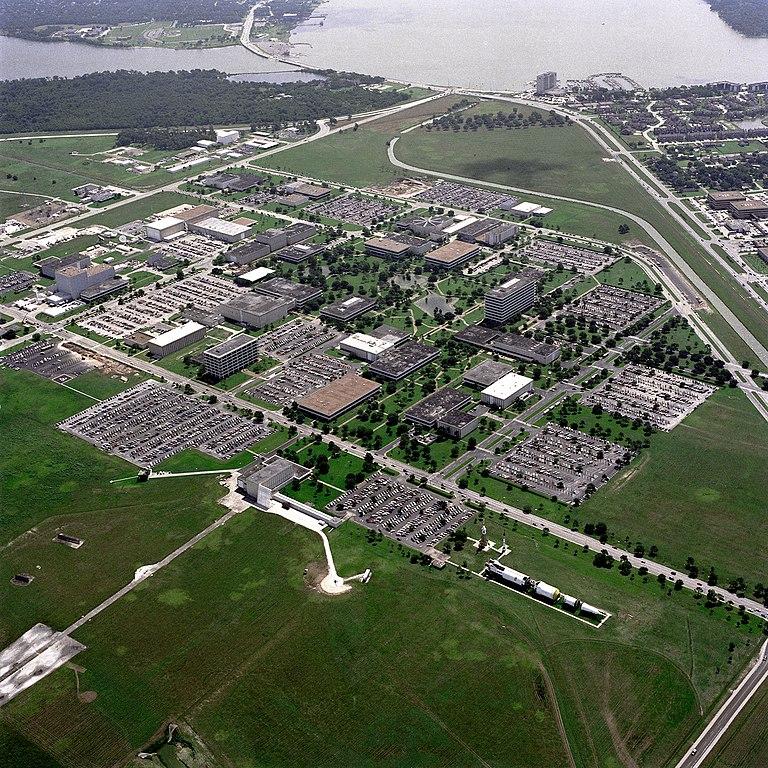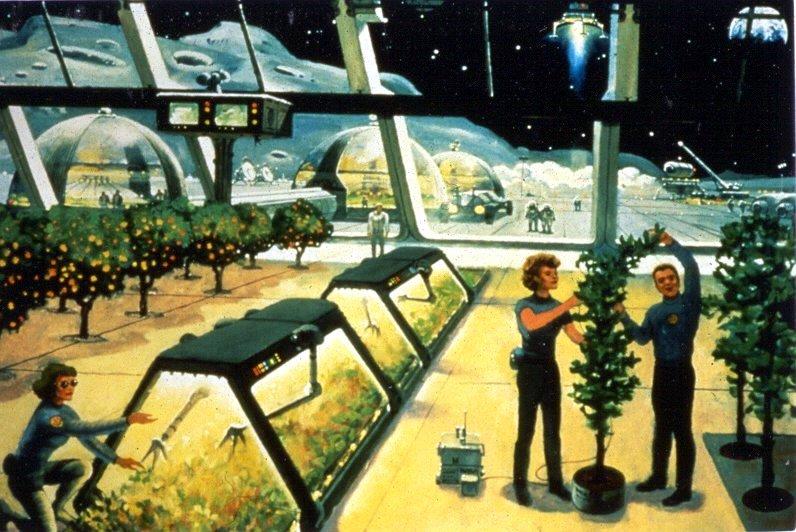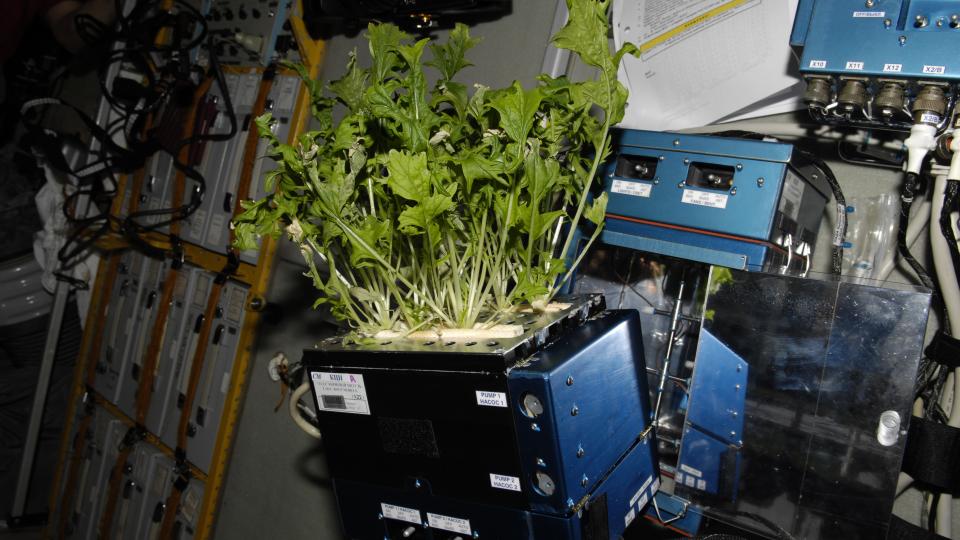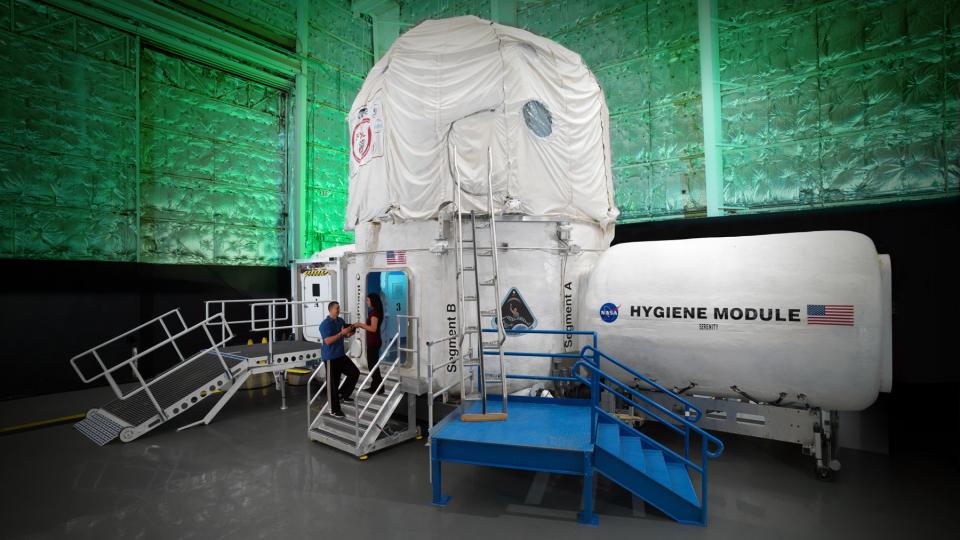
Aerial view of the Johnson Space Center in Houston, Texas, 1989.
Aerial view of the Johnson Space Center in Houston, Texas, 1989.
Photograph by NASA, 10 August 1989.
Accessed via Wikimedia on 8 April 2019, click here to view source.
 This work is licensed under a Creative Commons Public Domain Mark 1.0 License.
This work is licensed under a Creative Commons Public Domain Mark 1.0 License.
Echoing John F. Kennedy’s 1962 speech calling for Americans to land a man on the moon, president Ronald Reagan’s annual State of the Union address of 25 January 1984 called for an American space station named Freedom within a decade. Reagan’s announcement was a set piece Cold War moment. The United States had had several successful space shuttle launches but knew that the Soviet Union already had two space stations aloft and occupied, Soyuz and Salyut, from 1969 to 1982, which had showed up America’s first short-lived Skylab space station of the early 1970s. Reagan knew that the Soviet Union was planning a grander station, Mir, for 1986. As the next move in the bipolar international game, Freedom was envisioned by NASA to be a self-sufficient station with a closed environment that would recycle air, food, and water back to the crew.

Lunar Farm. The ability to grow food locally will be vital to economically sustaining human presences on the moon, on other planets, and in orbital habitats.
Lunar Farm. The ability to grow food locally will be vital to economically sustaining human presences on the moon, on other planets, and in orbital habitats.
Unknown artist.
Courtesy of Space Studies Institute (SSI).
Accessed on 8 April 2019, click here to view source.
 This work is licensed under a Creative Commons Attribution 3.0 Unported License.
This work is licensed under a Creative Commons Attribution 3.0 Unported License.
The end of the Cold War saw Freedom folded into the International Space Station (ISS). The first ISS components were launched in 1998 not as an American national mission but as an international joint project with Russia, Japan, and Europe. Unlike the hope that Freedom would be self-contained, the ISS remains firmly tethered to Earth for its supply. It had been hoped that Freedom would build on decades work on bioregenerative systems, which meant using living organism and bacteria to process waste into nutrients. NASA’s life scientists said over 40 years ago that closed bioregenerative systems were necessary to create a self-sustaining environment in space, yet even now the ISS recycles only a fraction of its expensively-supplied-from Earth water, air, and food. The ISS is thus a microcosm of one current environmental predicament: the real challenge is not so much technical capability of building waste recycling systems as the social and political resistance to using our own waste as food and water.
The quest to engineer a closed artificial environment illuminates the silent underside of human attitudes towards their environment. Environments are believed to be wildernesses or wastelands, natural or polluted, but those conceptions do not place organic waste on a par with plants and animals. In any complex environment, an animal’s defecation is as significant as it patterns of feeding, yet environmental campaigns for protection and preservation never advocate safeguarding feces. But the environment that NASA had to build for space had to deal explicitly with waste. Pioneering environmental historian Donald Worster came to the conclusion that historians have not paid enough attention to excremental histories, bowdlerizing environmental history by focusing on where food comes from and not where the waste goes. Often so poignant at illuminating how nature is understood and has been used, environmental history stops short when it confronts unsightly and odorous waste. When anthropologist Lisa Messeri spent a week with the crew of the Mars Society’s Mars Desert Research Station (MDRS) in Utah playing out a simulation of a Mars mission, for example, she noted their intense discussions about science fiction or their hokey spacesuits worn while walking around outside, but she reported no talk about using the toilet or drinking their own recycled waste water. Yet we know from Greg Klerkx, a former manager of SETI and a journalist, that the MDRS toilets were the source of continuous jokes and occasional exasperation.

Mizuna lettuce growing aboard the International Space Station before being harvested and frozen for return to Earth.
Mizuna lettuce growing aboard the International Space Station before being harvested and frozen for return to Earth.
Photograph by NASA, 2010.
 This work is licensed under a Creative Commons Public Domain Mark 1.0 License.
This work is licensed under a Creative Commons Public Domain Mark 1.0 License.

Current Life Support Mission Analogue at the Johnson Space Flight Center.
Current Life Support Mission Analogue at the Johnson Space Flight Center.
Photograph by U.S. Department of Defense.
The appearance of U.S. Department of Defense (DoD) visual information does not imply or constitute DoD endorsement.
 This work is licensed under a Creative Commons Public Domain Mark 1.0 License.
This work is licensed under a Creative Commons Public Domain Mark 1.0 License.
To live among the stars, ironically, always meant solving the down-to-earth problem of sustainable waste management. Hard-nosed NASA engineers planning Skylab, then Freedom, and finally the ISS always spoke forthrightly about their focus on the dirt, muck, odor, and excrement. As early as 1965 NASA’s Langley Research Center assembled a system capable of recycling water and oxygen to support four men for 90 days without resupply. Thirty years later, this difficult developmental work continued when NASA conducted a series of closed environment tests on the life support modules at the Johnson Space Center in Houston, Texas. For 91 days in 1997, a four-person crew of three men and one woman co-existed with growing wheat; organic waste became organic fertilizer, cycles of O2 and CO2 were stabilized, and water flowed through humans and plants, pipes and condensers, and the air and the soil. Remarkably, that crew fertilized their crops with their own feces processed through a new “Solid Waste Incineration System” (SWIS), which burnt the waste to render it mostly into CO2 which was re-introduced into the growth chambers. It fed their “GARDEN,” that is, the “Growth Apparatus for the Regenerative Development of Edible Nourishment,” which grew lettuce as a welcome addition to the otherwise pre-prepared, frozen food. The use of organic waste as nutrients for crops was hardly a new concept for the space program’s life scientists and engineers, but putting this idea into practice was far from a matter of course. Air was fully recycled as was the water from the shower, washbasin, and laundry as well as their urine. Their waste water was returned to the crew as drinking water, over 200 kg of it, as well as just over 3000 kg of shower, wash, and laundry water.
My conclusion is that to live in space, rather than just continue to be tourists, is analogous to continuing to live on Earth rather than just treating our planet as visitors. The creation of, and living with, sustainable waste systems is vital. Indeed, saving the bacteria in shit in the Anthropocene is as important to the environment as saving the tiger.
How to cite
Munns, David. “What Living in Space Teaches Us about Living on Earth.” Environment & Society Portal, Arcadia (Spring 2019), no. 14. Rachel Carson Center for Environment and Society. doi.org/10.5282/rcc/8704
ISSN 2199-3408
Environment & Society Portal, Arcadia
 This work is licensed under a Creative Commons Attribution-ShareAlike 4.0 International License.
This work is licensed under a Creative Commons Attribution-ShareAlike 4.0 International License.
2019 David Munns
This refers only to the text and does not include any image rights.
Please click on an image to view its individual rights status.
- Höhler, Sabine. Spaceship Earth in the Environmental Age, 1960–1990. New York: Routledge, 2016.
- McCray, W. Patrick. The Visioneers: How a Group of Elite Scientists Pursued Space Colonies, Nanotechnologies, and a Limitless Future. Princeton: Princeton University Press, 2013.
- Munns, David P. D., and Kärin Nickelsen. “To Live Among the Stars: Artificial Environments in the Early Space Age.” History and Technology 33, no. 3 (2017): 272–299.
- Klerkx, Greg. Lost in Space: The Fall of NASA and the Dream of a New Space Age. New York: Pantheon Books, 2004.
- Roach, Mary. Packing for Mars: The Curious Science of Life in the Void. New York: W.W. Norton, 2010.








